庐山手绘资料 沙沛 陈红卫 余工
- 格式:doc
- 大小:19.94 MB
- 文档页数:13
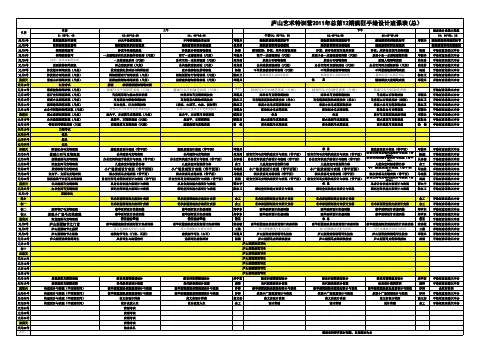
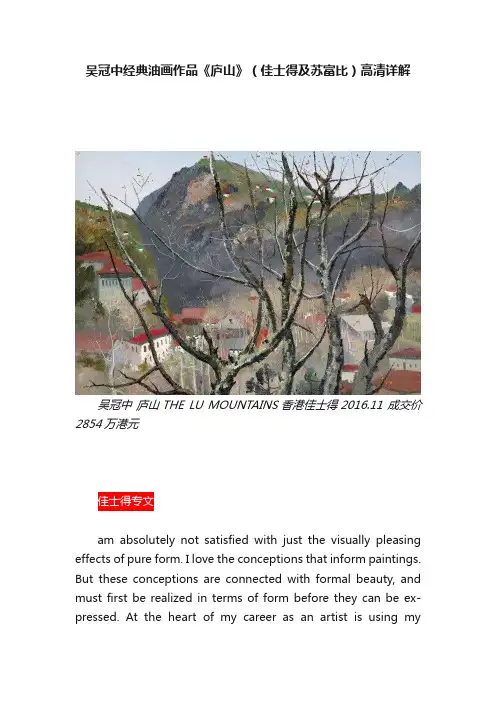
吴冠中经典油画作品《庐山》(佳士得及苏富比)高清详解吴冠中庐山 THE LU MOUNTAINS 香港佳士得2016.11 成交价2854万港元佳士得专文am absolutely not satisfied with just the visually pleasing effects of pure form. I love the conceptions that inform paintings. But these conceptions are connected with formal beauty, and must first be realized in terms of form before they can be ex-pressed. At the heart of my career as an artist is using mypainter's eye to discover the conception associated with an image.- Wu Guanzhong, 'On Oil Painting, Bitter and Sweet'In 1936, Wu Guanzhong entered the National Academy of Art in Hangzhou founded by Lin Fengmian, initially studying oil painting under Chang Shuhong, and thereafter learning Chinese traditional painting from Pan Tianshou. In 1947, after excelling in examination, he was admitted to government-funded study in France, where he entered the École nationale des beaux-arts for a three-year course of study. There, he gained a deep understanding of the essence of Western modern art, such as Impressionist colours, post- Impressionist visuality, Fauvist complete unleash of freedom, Cubist new form of ex-pression. Upon his return to China, Wu Guanzhong embarked upon an inspirational fusion of Chinese traditional and Western modern art to create a third way, by employing ink and paper as its carrier, at the same time combining with concepts in Western modern art. In particular, Wu made breakthrough innovation to concepts and techniques and renewed visual language in terms of composition and structure, brushstroke and coloration. In this way, he inherited from and further developed Chinese ink painting, and thereby inaugurated a new era.吴冠中庐山 THE LU MOUNTAINS 局部细节Under the political circumstances prevailing in China during the Cultural Revolution, Wu Guanzhong ended up being 'sent down' to the countryside several times for 'reform through labour.' That, however, did not dampen his fervent pursuit of painting, but served instead to focus his attention even more strongly on landscape-themed works. During the hours he spent at farm labour, he came to the realization that any interpretation of beauty must be sought in nature, and further, that one's own thoughts and feelings must become part of the scenes depicted — a realization that helped produce many successful works. TheLu Mountains (Lot 2504), dating from 1974, is Wu Guanzhong's most representative work from the 1970s, when his work in the oil medium was at its peak. In it Wu finds a precise balance between realism and a more freestyle (or xieyi) approach. The work is filled with freestyle brushwork of great abstract beauty, along with bold, solid lines that find a complement in others less distinct. Combined with these is the natural flavour of Wu's simple, earthy colours, while the structural relationships between his colours and lines produces the finely managed sense of space and depth in The Lu Mountains.In The Lu Mountains, Wu Guanzhong boldly chooses to make trees and branches a dominating presence in the foreground of the work. These he sets out in strong, distinctive, and vivid brushwork, using horizontal strokes to create texture in the tree trunks, while the fine lines of slimmer branches are etched out of the pigment on the canvas. Wu's composition allows viewers to imaginatively enter into the scene, touching their feelings with the sense of glimpsing beautiful scenes in the distance through the branches. This double presentation of close-up branches with more distant vistas adds a wealth of poetic energy to this otherwise realistic scenic presentation. A shift in our viewpoint occurs as our eyes moves from the close foreground toward the white buildings and red-tile roofs in the valley, and then further on to the grand rise of the mountain peak in the distance. The artist guides us as we roam through the landscape: here there are mountain paths to walk, distant peaks at which to gaze, and homes in which to live. Song Dynasty painter Guo Xi once spoke of paintings in which 'there are landscapes with places to walk, vistas to gaze at, paths to roam, and houses in which to live,' and Wu Guanzhong here offers a fresh new interpretation of that view.吴冠中庐山 THE LU MOUNTAINS 局部细节The pictorial space of The Lu Mountains is dominated by Wu's strong, ex-pressive lines, somewhere between freestyle abstraction and naturalistic realism, which call to mind the decorative screens produced by Japanese artist Ogata Korin (Fig.1) or the highly stylized landscape paintings of Gustav Klimt (Fig.2). Korin eliminated any background in order to highlight his shapes and forms and the appeal of his subject; Klimt, on the other hand, provides a profusion of detail with multitudes ofrepeated points and lines. Wu Guanzhong's ex-pressive approach is more elegant in its easy, effortless, yet reserved manner, and in this painting, which is lucid and understandable yet invested with deep feeling, he finds magnificent beauty in the ordinary. His brushwork is free and varied but never dense or complicated in the least, and his accurate depiction of the relative sizes, heights, and distances of objects allows the painting to exude a sense of precisely ordered beauty. The ex-pression of rich detail without losing sight of the overarching order bespeaks a certain kind of aesthetic and a mature technique, closely linked to the aesthetic traditions behind Chinese landscape paintings and the grand sweep of their conceptions.Beyond its finely managed composition, The Lu Mountains also features rich colour and meticulous layering. In the trees and mountains, Wu employs alternating areas of cool and warm tones in pigments which have the same kind of bright, saturated colours and earthy textures seen in natural minerals. From the broad perspective of art history, the jumbled blocks of colours in The Lu Mountains could perhaps be seen as inspired by Cezanne, though Wu moves beyond the purely formal beauty of Cezanne's work. Cezanne simplified and then reconstructed his scenery, emphasizing vertical and horizontal spatial extension in tightly structured compositions that can seem slightly confined (Fig. 3). Wu Guanzhong, however, by means of brushstrokes and colours that vary from dense to diffuse, ex-presses depth, distance, and openness within the flat spatial structure of the canvas. He injects a natural, intuitive sensibility into the work, and his feel for the resilient life force of the land conveys its flourishing vitality to the viewer. Wu Guanzhong surmounts the restrictions of the flat canvas through his precise grasp of line, colour, and structure,and in each minute area of the painting we find spaces where the imagination can roam. His brushstrokes in oil seem to possess a concentrated power that adds body and life, making real the relationships between scenic objects, as if there were another hidden dimension beyond his flat canvas. Brushstrokes are vivid and lifelike, and small touches of abstract beauty can be found within larger areas of figurative depiction. But these smaller sections carry traces that suggest the whole, while the whole exists in an overall unity within each of its parts. Wu Guanzhong thus reaches the highest summit of this kind of freestyle aesthetic, echoing the English poet William Blake's famous line about imagination: 'to see the world in a grain of sand, and heaven in a wildflower.' The Lu Mountains reflects Wu Guanzhong's marvellous ability to find an image encompassing all of nature within some corner of its scenery, unrestricted by the size of his canvas. The Lu Mountains further reveals both his deep insights, and his ability to realize those insights in exciting ways, in terms of the mutual relationships between freestyle aesthetics and the shaping of forms, or in other terms, between abstraction and figuration in nature. The Lu Mountains displays all the elements that made Wu Guanzhong's art great.吴冠中庐山 THE LU MOUNTAINS 局部细节Wu Guanzhong's pursuit of 'beauty of form' clearly differs from the modern formalism of the West; it is part of a more Eastern cultural vocabulary, closely tied to national sentiments. It is also deeply rooted in the perceptions of beauty gained during his rural life, from which evolved his unique and innovative creative vocabulary. Such a vocabulary served to present in art his actual experiences of the time, but also drew on the essence of the Chinese landscape painting tradition, a tradition not limited by the distinctions made in the West between abstraction and figuration. As he once wrote, 'In oil landscapes there aremountains, rivers, trees, houses....ex-pressing these concrete images is not too difficult. But it is the abstract forms of the organizing structural relationships between these concrete objects— that is, the upward or downward motion they produce, the squares, circles, curves, and straight lines, and warm or cool colors—and their responses to each other, their degree of concentration or expansion, and so on, that are actually crucial in determining whether a work is beautiful or not, or whether its conception succeeds.' If Wu Guanzhong's work is understood on this basis, then figuration and abstraction are simply two sides of the same coin, and the key lies in whether the artist's forms and ideas are capable of ex-pressing a conception that will touch the viewer. Put another way, what matters is whether technique and materials, through the shaping and structuring of the artist, can communicate the experience of the spirit. The poet Su Shi once wrote about the Lu Mountains that 'viewed from a distance, they seem a mountain range; from the side, a single peak,' reflecting the way in which the same mountain presents vastly different aspects from different viewpoints. This metaphorically describes the challenge faced by modern Chinese artists as they brought their Eastern aesthetic viewpoint into their work in a new medium. Wu Guanzhong's The Lu Mountains shows just how capable he was at solving this problem.The Lu Mountains makes absolutely clear that in the history of Chinese art, Wu Guanzhong enjoyed magnificent success in two important areas: creating works that reflected a national spirit, and developing innovative new approaches to painting.吴冠中庐山 THE LU MOUNTAINS 局部细节苏富比中文介绍吴冠中70年代经典作品《庐山》现世「在欧洲我考验了自己、照见了自己,今天,我对西洋现代艺术的爱好与崇拜之心念完全动摇了,我不愿以我的生命来选一朵花的职业,如果绘画只是仅求一点视觉的轻快,妆点了一角室壁的空虚,它应该更千倍地被人轻视!十年,我一步步追,一步步爬,在寻找一个连自己也不太清楚的目标,一个穷乡僻壤的孩子,爬到了这个西洋寻求欢乐社会的中心巴黎,到处看,我知道这个社会,这个人群与我不相干,灯红酒绿的狂舞对我太生疏…踏破铁鞋无觅处,艺术的学习不在欧洲,不在大师们的画室里,在祖国,在故乡,在家园,在自己的心底,我决定回国!」这是1950年,吴冠中从法国寄给他在杭州艺专的老师吴大羽的一封信。
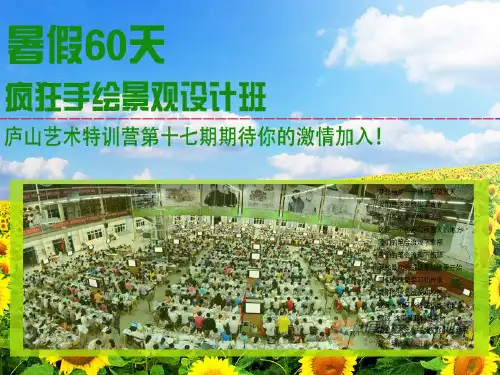
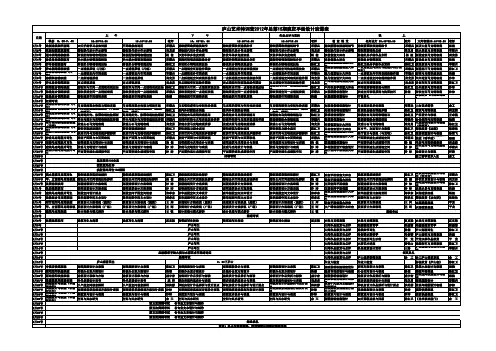
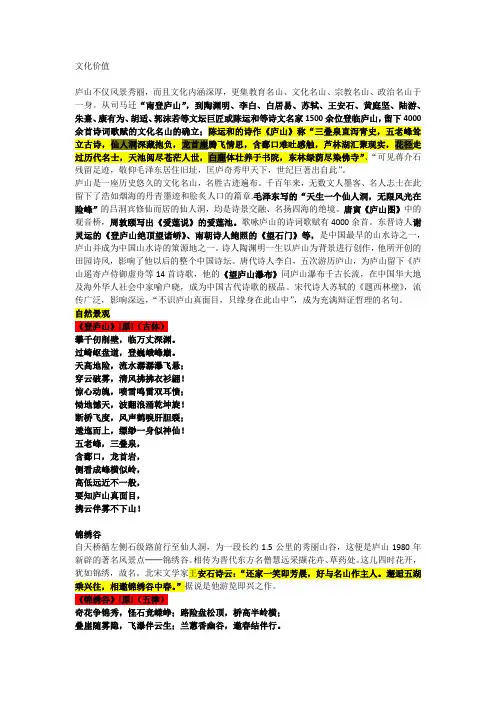
文化价值庐山不仅风景秀丽,而且文化内涵深厚,更集教育名山、文化名山、宗教名山、政治名山于一身。
从司马迁“南登庐山”,到陶渊明、李白、白居易、苏轼、王安石、黄庭坚、陆游、朱熹、康有为、胡适、郭沫若等文坛巨匠或陈运和等诗文名家1500余位登临庐山,留下4000余首诗词歌赋的文化名山的确立;陈运和的诗作《庐山》称“三叠泉直泻青史,五老峰耸立古诗,仙人洞深藏抱负,龙首崖腾飞情思,含鄱口难吐感触,芦林湖汇聚现实,花径走过历代名士,天池阅尽苍茫人世,白鹿体壮养于书院,东林绿荫尽染佛寺”、“可见蒋介石残留足迹,敬仰毛泽东居住旧址,匡庐奇秀甲天下,世纪巨著出自此”。
庐山是一座历史悠久的文化名山,名胜古迹遍布。
千百年来,无数文人墨客、名人志士在此留下了浩如烟海的丹青墨迹和脍炙人口的篇章.毛泽东写的“天生一个仙人洞,无限风光在险峰”的吕洞宾修仙而居的仙人洞,均是诗景交融、名扬四海的绝境。
唐寅《庐山图》中的观音桥,周敦颐写出《爱莲说》的爱莲池。
歌咏庐山的诗词歌赋有4000余首。
东晋诗人谢灵运的《登庐山绝顶望诸峤》、南朝诗人鲍照的《望石门》等,是中国最早的山水诗之一,庐山并成为中国山水诗的策源地之一。
诗人陶渊明一生以庐山为背景进行创作,他所开创的田园诗风,影响了他以后的整个中国诗坛。
唐代诗人李白,五次游历庐山,为庐山留下《庐山遥寄卢侍御虚舟等14首诗歌,他的《望庐山瀑布》同庐山瀑布千古长流,在中国华大地及海外华人社会中家喻户晓,成为中国古代诗歌的极品。
宋代诗人苏轼的《题西林壁》,流传广泛,影响深远,“不识庐山真面目,只缘身在此山中”,成为充满辩证哲理的名句。
自然景观《登庐山》[原](古体)攀千仞削壁,临万丈深渊。
过崎岖盘道,登巍峨峰巅。
天高地险,流水潺潺瀑飞悬;穿云破雾,清风拂拂衣衫翩!惊心动魄,喷雪鸣雷双耳愦;恸地憾天,波翻浪涌乾坤旋!断桥飞度,风声鹤唳肝胆裂;逶迤而上,缥缈一身似神仙!五老峰,三叠泉,含鄱口,龙首岩,侧看成峰横似岭,高低远近不一般,要知庐山真面目,携云伴雾不下山!锦绣谷自天桥循左侧石级路前行至仙人洞,为一段长约1.5公里的秀丽山谷,这便是庐山1980年新辟的著名风景点──锦绣谷。
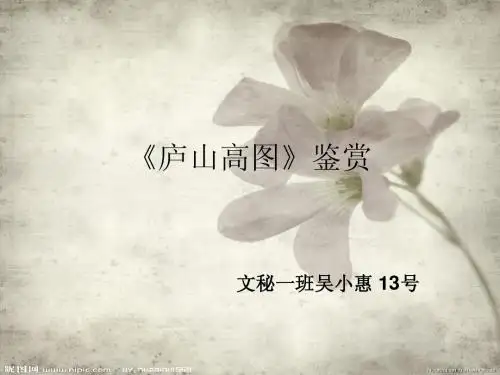

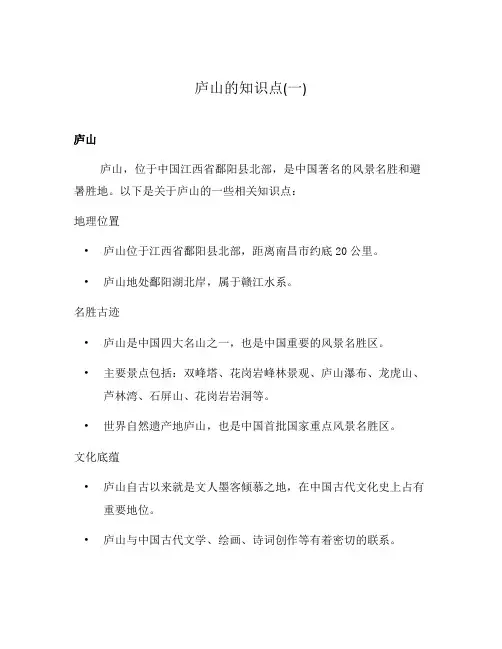
庐山的知识点(一)庐山庐山,位于中国江西省鄱阳县北部,是中国著名的风景名胜和避暑胜地。
以下是关于庐山的一些相关知识点:地理位置•庐山位于江西省鄱阳县北部,距离南昌市约底20公里。
•庐山地处鄱阳湖北岸,属于赣江水系。
名胜古迹•庐山是中国四大名山之一,也是中国重要的风景名胜区。
•主要景点包括:双峰塔、花岗岩峰林景观、庐山瀑布、龙虎山、芦林湾、石屏山、花岗岩岩洞等。
•世界自然遗产地庐山,也是中国首批国家重点风景名胜区。
文化底蕴•庐山自古以来就是文人墨客倾慕之地,在中国古代文化史上占有重要地位。
•庐山与中国古代文学、绘画、诗词创作等有着密切的联系。
•庐山闻名于古代文人墨客的写作成果,如庐山谣、庐山赋、庐山诗等。
生态环境•庐山是中国的国家级自然保护区和国家重点风景名胜区,拥有丰富的生物资源。
•庐山的红外松、狮子峰薄壳松等珍稀树种被列为国家重点保护树种。
•庐山的动植物资源丰富多样,有众多珍稀物种,如云豹、红腹蛙等。
旅游特色•庐山是中国的著名避暑胜地,夏季气候凉爽宜人。
•旅游景点众多,有丰富的自然景观和人文景观。
•著名的旅游线路包括鼎湖、庐峰、龙虎、三清等。
以上是关于庐山的一些相关知识点,庐山以其独特的地理、文化和自然环境吸引着众多游客和文化爱好者前来参观和探索。
无论是追求自然风光还是寻找文化底蕴,庐山都是一个不可错过的目的地。
以下是对庐山的一些进一步详细解释:地理位置庐山位于中国江西省鄱阳县北部,地处鄱阳湖北岸,是江西省的著名景区和风景名胜区。
庐山的地理位置优越,距离省会南昌市仅约20公里,交通十分便利。
名胜古迹庐山是中国四大名山之一,也是中国重要的风景名胜区之一。
庐山以其独特的山峦、悬崖、瀑布和湖泊风景而闻名于世。
庐山的主要景点包括双峰塔、花岗岩峰林景观、庐山瀑布、龙虎山、芦林湾、石屏山、花岗岩岩洞等,这些景点带给人们无限的美感和惊叹。
文化底蕴庐山自古以来就是文人墨客倾慕之地,它与中国古代文学、绘画、诗词创作等有着密切的联系。
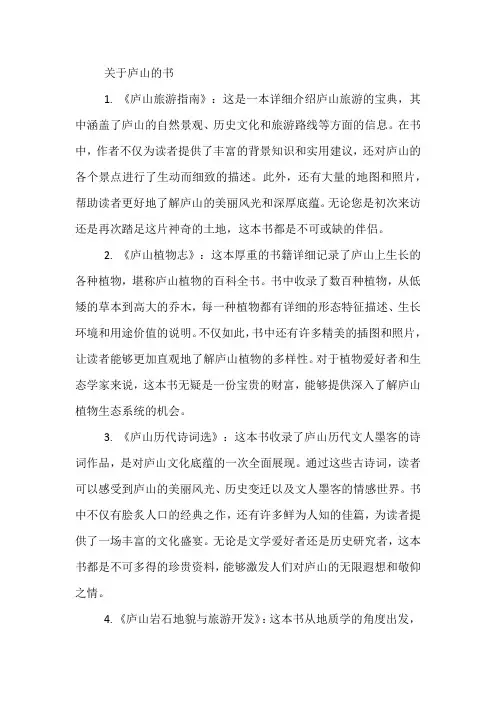
关于庐山的书1. 《庐山旅游指南》:这是一本详细介绍庐山旅游的宝典,其中涵盖了庐山的自然景观、历史文化和旅游路线等方面的信息。
在书中,作者不仅为读者提供了丰富的背景知识和实用建议,还对庐山的各个景点进行了生动而细致的描述。
此外,还有大量的地图和照片,帮助读者更好地了解庐山的美丽风光和深厚底蕴。
无论您是初次来访还是再次踏足这片神奇的土地,这本书都是不可或缺的伴侣。
2. 《庐山植物志》:这本厚重的书籍详细记录了庐山上生长的各种植物,堪称庐山植物的百科全书。
书中收录了数百种植物,从低矮的草本到高大的乔木,每一种植物都有详细的形态特征描述、生长环境和用途价值的说明。
不仅如此,书中还有许多精美的插图和照片,让读者能够更加直观地了解庐山植物的多样性。
对于植物爱好者和生态学家来说,这本书无疑是一份宝贵的财富,能够提供深入了解庐山植物生态系统的机会。
3. 《庐山历代诗词选》:这本书收录了庐山历代文人墨客的诗词作品,是对庐山文化底蕴的一次全面展现。
通过这些古诗词,读者可以感受到庐山的美丽风光、历史变迁以及文人墨客的情感世界。
书中不仅有脍炙人口的经典之作,还有许多鲜为人知的佳篇,为读者提供了一场丰富的文化盛宴。
无论是文学爱好者还是历史研究者,这本书都是不可多得的珍贵资料,能够激发人们对庐山的无限遐想和敬仰之情。
4. 《庐山岩石地貌与旅游开发》:这本书从地质学的角度出发,对庐山的岩石地貌进行了深入的研究和探讨。
作者通过对庐山的地质构造、岩石类型和形成过程等方面的分析,让读者对庐山的地质历史有了更加深入的了解。
同时,书中还就如何在保护自然环境的前提下进行旅游开发进行了详细论述,为地质学和旅游管理专业人士提供了有价值的参考意见。
通过阅读这本书,读者不仅能够领略到庐山岩石地貌的壮美景色,还能对环境保护和旅游开发有更深刻的认识和思考。
5. 《庐山云雾茶》:这本书专门介绍了庐山的云雾茶,是庐山茶文化的集大成之作。
书中详细介绍了云雾茶的历史渊源、制作工艺、品质特点以及品饮文化等方面的知识。

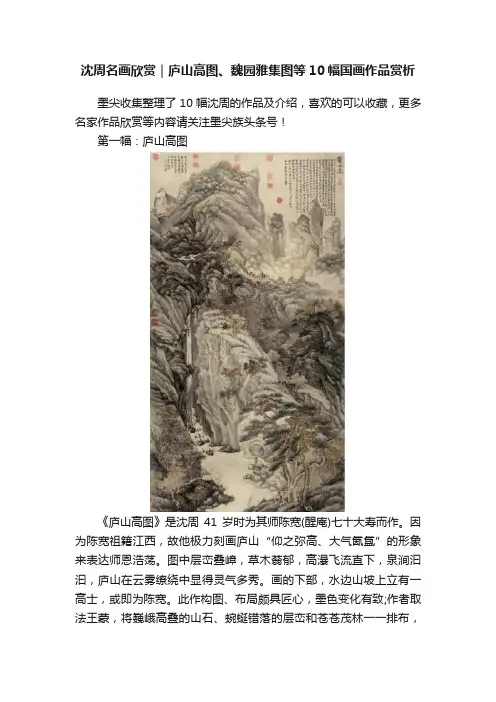
沈周名画欣赏|庐山高图、魏园雅集图等10幅国画作品赏析墨尖收集整理了10幅沈周的作品及介绍,喜欢的可以收藏,更多名家作品欣赏等内容请关注墨尖族头条号!第一幅:庐山高图《庐山高图》是沈周41岁时为其师陈宽(醒庵)七十大寿而作。
因为陈宽祖籍江西,故他极力刻画庐山“仰之弥高、大气氤氲”的形象来表达师恩浩荡。
图中层峦叠嶂,草木蓊郁,高瀑飞流直下,泉涧汩汩,庐山在云雾缭绕中显得灵气多秀。
画的下部,水边山坡上立有一高士,或即为陈宽。
此作构图、布局颇具匠心,墨色变化有致;作者取法王蒙,将巍峨高叠的山石、蜿蜒错落的层峦和苍苍茂林一一排布,整个画面疏密有度,松紧有序,有条不紊。
此作品堪称沈周经典之作,也是他转型时期的代表作。
第二幅:魏园雅集图这是沈周43岁时的画作。
此轴绘五人山亭雅集之事。
画面下方正中有一茅亭临渚而筑,茅亭内四人席地而坐,书童侧立一旁,一老者曳杖而行,前往草亭。
由远及近,有山石磊磊,山涧飞流直挂,小溪淙淙,溪边小桥,杂树数株,红似火的枫叶点缀其间。
有景物,有声色,有人境,营造了一种山水亭榭、林泉雅集的氛围。
在技法上皴染兼施,气息雄浑沉静,画上共六人题咏,实为诗书画融为一体的佳作。
第三幅:桃花书屋此画为作者思念逝去的弟弟时所作,构图采用高远法,仿王蒙笔意,山石皴染洗练沉着,黑白虚实巧妙。
墨色浓淡相宜,近处山石圆浑,苔点温润,间以老树数株,一老者独坐草阁之中。
根据画卷上方题记,可知此阁乃沈周家宅,阁中老者似是沈周自己,表现出对弟弟“今日看花唯我在,一场春梦泪痕边”的思亲之情。
第四幅:飞来峰图此画为沈周成化庚子年(1480)五月夜宿飞来峰下而作。
画面构图饱满雄健,气韵高清,墨色浓淡相间,虚实结合,山峦清旷。
峰下淙淙溪水,溪上小桥,近处一亭,亭边二人,其一负手而立,似沉浸在飞来峰和山林之中,画面气息高雅,意境幽微。
第五幅:虎丘送客图虎丘位于苏州城西北郊,素有“吴中第一名胜”之美誉,也是文人墨客雅聚吟咏的绝佳场所。
明唐寅《匡卢图》高清鉴赏
《匡庐图》轴,明,唐寅绘,绢本设色,纵148.5厘米,横72.2厘米,安徽省博物馆藏。
唐寅,明代著名画家、书法家、诗人。
字伯虎,后改字子畏,号六如居士、桃花庵主、鲁国唐生、逃禅仙吏等,江苏苏州人。
其画山水、人物、仕女、楼观、花鸟,无不臻妙。
山水师周臣,皴法学李唐、刘松年。
自称“江南第一风流才子”。
绘画上,与沈周、文徵明、仇英并称“吴门四家”,又称“明四家”。
诗文上,与祝允明、文徵明、徐祯卿并称“吴中四才子”。
《匡庐图》又名《庐山图》或《庐山三峡桥》,为全景山水,表现的是庐山三峡桥(又称观音桥)一带的景观,画面峰岩嵯峨,古木惨淡,瀑泉湍泻,画风清刚俊逸,而意境却萧索苍冷。
《匡庐图》呈现给观众的是萧索、压抑、沉重的情感色彩。
这种自然物象的色彩,隐现了诗人心理情绪的色彩。
唐寅寓情于画,借画隐晦曲折地抒发自己的压抑情绪,折射出作者一段坎坷的经历。
《匡庐图》上的景物有三个层次:前景是嵯峨的岩石上,挺立着几棵枝丫交错的古树,在朔风中落叶纷飞,老枝纷披;中景是一段玉带似的白云,横亘山腰,白云中隐现出一道瀑布,从山垭间喷薄而出,顺着山势,几经曲折,化为一泓碧水,荡漾在山脚下;远景是一排险峭的山峰,如戟似剑,直刺苍穹;右下端画了一道横跨山涧的山桥,桥上一老者骑驴过桥,一童子尾后。
唐伯虎诗言志,画寓怀,画中题诗:“匡庐山前三峡桥,悬流溅扑鱼龙跳。
赢骖强策不肯度,古木惨淡风萧萧。
”款署:“唐寅子畏”。
庐山植被垂直分布示意图主要植物种类识别:(一)、海金砂科(Lygodiaceae)1.海金砂(Lygodium japonicum.sw)—--多年生草木、叶轴细长,缠绕他物上升,长1-2米;叶鞘革质,二次羽状分裂;生孢子囊之叶分裂细,背面缘边有生孢子囊群。
广布于暖温带,亚热带各地。
(二)、乌毛蕨料(Blechunaceae)狗背(Woodwardia japonica(L.F.)J.Smith)—--叶通常二次羽状分裂,根茎匍匐,叶柄直立,长16-30厘米;华中,华南常见的酸性土的指示植物。
(三)、紫萁科(薇科)(Osmundaceae)1.铁芒箕(Dicranopteris dichotoma Bernh)——多年生之蕨类植物,根状茎横生,披锈毛,叶轴重复,假二歧分叉上部几回分叉的主轴两侧均无小羽片,但在分叉处两侧之下方通常有一对托叶状之羽片,叶轴最后一次分叉之顶端发出一对蓖齿状之羽片,叶背面灰白色,细脉呈羽状分叉每组4条,孢子囊群细小,园形,一列生于细脉之中段。
广布于长江以南各省,生强酸性士的红壤丘陵荒坡或马尾松林下。
2.紫萁(薇)(Osmunda japonlca)——多年生草本,羽状复叶,小叶似菜刀型,分布于长江流域,为酸性士指示植物。
(四)、松科(Pinaceae)1.黄山松(Pinus Taiwanensis Hayata)——又称台湾松,常绿乔木,高达20余米,枝平展,干皮深灰色,裂成不规则的鳞状厚块片,叶二针一束,稍直硬,暗绿色,球果卵形,长5-6厘米。
在中亚热带地区海拔700米以上有分布。
2.金钱松(Pseudolarix amabilis)——落叶乔木,有长短枝之分。
叶生于短枝,15-20枚叶片簇生,由叶柄轮状平展,叶长3-7厘米,宽2-4毫米,前端尖。
分布于浙江、安徽大别山、黄山、江西庐山、四川万县等地,海拔1300米以下,喜生于光照充足,温暖多雨、土壤肥厚,排水良好的酸性土山区。
大小混杂,但磨圆度均较好。
其构造有层理构造和层面构造,主要受河流和风力作用影响而形成。
2、变质岩:庐山的变质岩主要由沉积岩经过区域变质作用形成大理岩、石英岩、板岩、片岩、片麻岩、角闪岩等,片岩居多。
其结构有等粒变晶结构、斑状变晶结构、鳞片变晶结构等,构造多为板状构造、千枚状构造、片状构造、块状构造,特点是呈块型或片型,片岩层理分明。
二、内容1.庐山的地层庐山主要由震旦纪及前震旦纪地层组成,其分布具有一定的规律性。
山体中部出露最宽,向东北部和西部收敛。
以九奇峰、仰天坪一带为界,将庐山地层分为南、北两部。
南部主要出露前震旦系双桥山群,庐山最高峰汉阳峰由前震旦纪喷出变流纹岩组成,因易受风化,故山峰略呈浑圆状,北部出露震旦系下统南沱组,该组分为上、中、下三部,各部岩性及其分布如以上表格所示。
2、地层分布1)山体南部主要出露前震旦系双桥山群地层。
庐山最高峰汉阳峰为前震旦纪喷出变流纹岩构成,因易受风化,故山峰略呈浑圆状。
2)山体北部出露震旦系下统南沱组地层。
3)庐山山体东南侧和西北侧,在温泉和莲花洞大断裂线以外,地层呈条带状分布,有愈向外时代愈新的趋势。
4)第四纪地层在山上山下均有分布,早更新统出露于山下临长江、十里铺等地。
中更新统山上山下均有出露,山上主要分布在谷地、山下广泛出露多组成岗丘。
晚更新统山上全新统分布于江湖地带及现代河流谷地,构成河漫滩、湖滩及心滩、边滩等,主要为黄色砂砾5)岩浆岩主要分布于本区南部和东南部地区,以喷出岩为主,少数为侵入岩。
3、庐山的地质构造(1)地质构造类型:一)褶皱构造:表现为两种构造方向,褶皱构造主要分布在庐山山体北部,褶皱轴线呈华夏系(NE)特征。
①是北东向,如大月山背斜、三叠泉(青莲寺)向斜等;②是北北东向,例如,通远向斜等属于短轴褶曲。
二)、断裂构造:①正断层:在庐山,属压扭性的断层沿横向断裂发育而成。
山体之东南麓有温泉正断层,穿过五老峰东南侧,在五老峰表现为阶梯是式断层。
瓷绘庐山风景雅赏作者:葛卫增来源:《收藏界》2015年第03期庐山,是世界级名山,是我国“三山五岳”中“三山”之一,地处江西省北部,风景区总面积382平方公里,山体面积282平方公里,主峰大汉阳峰海拔1474米,东偎鄱阳湖,南靠南昌滕王阁,西邻京九大通脉,北枕滔滔长江。
大江、大湖、大山浑然一体,雄奇险秀,刚柔并济,形成了世界上所罕见的壮丽景观,素有“匡庐奇秀甲天下”之美誉。
巍峨挺拔的青峰秀峦、喷雪鸣雷的银泉飞瀑、瞬息万变的云海奇观、俊奇巧秀的园林建筑,一展庐山的无穷魅力。
历史造就庐山,文化孕育庐山,名人喜爱庐山,世人赞美庐山。
中华民族源远流长的历史和数千年博大精深的文化蕴育了庐山无比丰厚的内涵,从司马迁“南登庐山”,到陶渊明、李白、白居易、苏轼、王安石、黄庭坚、陆游、朱熹、康有为、胡适、郭沫若等1500余位文坛巨匠登临庐山,留下4000余首诗词歌赋。
李白写的“飞流直下三千尺,疑是银河落九天”的秀峰马尾瀑,白居易写的“人间四月芳菲尽,山寺桃花始盛开”的庐山大林寺,苏轼写的“不识庐山真面目,只缘身在此山中”的庐山云雾,均是诗景交融、名扬四海的绝境。
庐山也成为中国山水诗的策源地之一。
山水诗在庐山大放光彩,山水画亦在庐山一展风流,闪烁出耀人的光辉。
东晋画家顾恺之创作的《庐山图》,成为中国绘画史上第一幅独立存在的山水画,从此历代丹青大师以庐山为载体,以绘画艺术形式对庐山赋予美感境界的表述,沈周、唐寅、荆浩等大师都有庐山山水画流传于世。
近现代文人瓷画兴起,景德镇陶瓷艺术家们常常到庐山写生,寻找素材,并巧妙地结合陶瓷的质感和美感,融入对庐山的眷恋和钟情,创作了一幅幅精美的庐山山水风景瓷画,“苍润高逸,秀出东南”,表现得淋漓尽致,观之有如身临其境。
王云泉彩绘《庐山飞瀑图》瓷板画高110厘米宽31厘米此瓷板为条屏,画面绘峻崖峭壁、苍松秀木及飞瀑。
山崖勾皴有章,层次明朗,以青绿色渲染,讲究冷暖变化,树木勾染细腻,深浓浅淡,湿润华滋,瀑布一泻千里,回旋有势,近崖与远山之间云烟缭绕,谷壑回声,气象万千。
论文性质:暑期实习报告论文题目:暑期实习综合报告专业班级:地理科学综合文科102班姓名:杨蓓学号:10980226成绩:暑期实习综合报告杨蓓109802261 尖峰山1.1 土壤尖峰山位于119°38E,29°10′N。
经检测,主要为壤土,垂直方向上,至上而下土壤由中壤土过渡为重壤土,再由重壤土过渡为中壤土。
有机碳含量为1922ppm-1.29%。
表1 尖峰山土样汇总表位置点地理坐标(东经)地理坐标(北纬)质地读数公式质地有机碳样品重有机碳含量PH值(H2O)PH值(HCL)山上上层119°38′03.6″29°10′05″17(17+2.5)/50g=0.39中壤土20.3mg 1.29% 5.36 5.43山上下层119°38′03.6″29°10′05″19(19+2.5)/50g=0.43中壤土22.0mg4616ppm4.26 3.51山下最下层119°38′12″29°9′45″21(21+2.5)/50g=0.47重壤土21.2mg2526ppm4.32 4.23山下中间层119°38′12″29°9′45″15(15+2.5)/50g=0.35中壤土21.9mg1922ppm4.09 4.52山下最上层119°38′12″29°9′45″13.5(13.5+2.5)/50g=0.32中壤土21.5mg6174ppm4.4 4.761.2 植物尖峰山海拔高427m,为独立丘陵,靠北山的群系山,坡向对称,坡度较陡,位于亚热带北部,降水丰富,年温差小,水热资源条件配合好,因此,植物种类较为丰富,生长茂密,保存有一定种类的森林植被。
尖峰山植物区系属泛北极植物区,中国—日本森林亚区,华东植物区系。
草本植物,特别是多年生植物,对生活环境的适应性很强,是组成林下植被的主要成员。